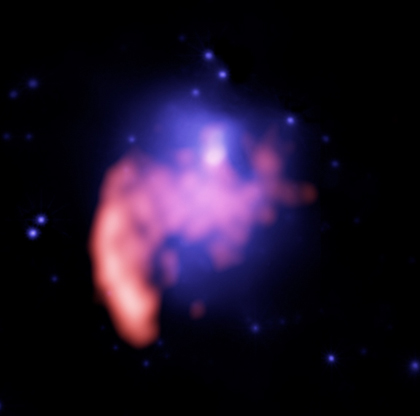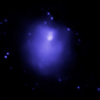For Release: October 15, 2008
NRL Release
 Image Credit: X-ray (NASA/CXC/INAF/G.Brunetti et al.); Radio (NRAO/NSF/INAF/G.Brunetti et al.)
Image Credit: X-ray (NASA/CXC/INAF/G.Brunetti et al.); Radio (NRAO/NSF/INAF/G.Brunetti et al.)
Press Image and Caption
(Washington, DC. 08)- A team of scientists, including astronomers from the Naval Research Laboratory (NRL), have detected long wavelength radio emission from a colliding, massive galaxy cluster which, surprisingly, is
not detected at the shorter wavelengths typically seen in these objects.
The discovery implies that existing radio telescopes have missed a large population of these colliding objects. It also provides an important confirmation of the theoretical prediction that colliding galaxy clusters accelerate electrons and other particles to very high energies through the process of turbulent waves. The team revealed their findings in the October 16, 2008 edition of Nature.
This new population of objects is most easily detected at long wavelengths. Professor Greg Taylor of the University of New Mexico and scientific director of the Long Wavelength Array (LWA) points out, "This result is just the tip of the iceberg. When an emerging suite of much more powerful low frequency telescopes, including the LWA in New Mexico, turn their views to the cosmos, the sky will 'light up' with hundreds or even thousands of colliding galaxy clusters." NRL has played a key role in promoting the development of this generation of new instruments and is currently involved with the development of the LWA. NRL radio astronomer and LWA Project Scientist Namir Kassim says "Our discovery of a previously hidden class of low frequency cluster-radio sources is particularly important since the study of galaxy clusters was a primary motivation for development of the LWA."
The discovery of the emission in the galaxy cluster Abell 521 (or A521 for short) was made using the Giant Metrewave Radiotelescope (GMRT) in India, and its long wavelength nature was confirmed by the National Science Foundation's (NRAO) Very Large Array (VLA) radio telescope in New Mexico. The attached image shows the radio emission at a wavelength of 125cm in red superimposed on a blue image made from data taken by the Chandra X-ray Observatory.
The X-ray emission comes from hot thermal gas, a well-known sign-post of massive galaxy clusters. Furthermore, its elongated shape indicates that the cluster has undergone a recent violent collision or "merger event" in which another group or cluster of galaxies was swallowed up by the gravitational potential of the main cluster. Interferometrics Inc. and NRL scientist Tracy Clarke, who is also the LWA System Scientist, notes "In addition to teaching us about the nature of Dark Matter, merging clusters are also important in studies of the mysterious nature of Dark Energy. Understanding these two strange components of the Universe will help us understand its ultimate destiny."
In the radio image there is a strong, oblong source of emission located on the lower left periphery of the X-ray gas detected by Chandra; this is a separate source. In the center of the cluster, within the region indicated by a dashed circle, there is radio emission which changes significantly with wavelength. At the longest wavelength (125 cm, shown) it is clearly detected, but at a wavelength of 49 cm it is much fainter, and it is almost entirely gone at 21 cm wavelength. This multi-wavelength picture of the diffuse emission is in good agreement with theoretical predictions for particle acceleration by turbulent waves generated by a violent collision.
In a broader astrophysical context, galaxy clusters are the largest gravitationally bound systems in the Universe and their collisions are the most energetic events since the Big Bang. Says team leader Gianfranco Brunetti (Instituto di Radioastronomia, Bologna, Italy), "The A521 system provides evidence that turbulence acts as a source of particle acceleration in an environment that is unique in the Universe due to its large spatial and temporal scales, and due to the low density and high temperature of the gas."
The team included scientists from Instituto di Radioastronomia, the University of Bologna, the Smithsonian Astrophysical Observatory, the National Radio Astronomy Observatory, and the Naval Research Laboratory. Basic research in radio astronomy at the Naval Research Laboratory is supported by 6.1 base funding. The NRAO is a facility of the National Science Foundation operated under cooperative agreement by Associated Universities, Inc. The GMRT is run by the National Centre for Radio Astrophysics of the Tata Institute of Fundamental Research. The LWA, funding for which is provided by the Office of Naval Research, is led by the University of New Mexico, and includes NRL, The Applied Research Laboratory at the University of Texas at Austin, Virginia Tech, the Los Alamos National Laboratory, and the University of Iowa, with contributions and cooperation from NRAO.
The Long Wavelength Array (LWA) website is http://lwa.unm.edu
The Naval Research Laboratory is the Department of the Navy's corporate laboratory. NRL conducts a broad program of scientific research, technology, and advanced development. The Laboratory, with a total complement of nearly 2,500 personnel, is located in southwest Washington, DC, with other major sites at the Stennis Space Center, MS; and Monterey, CA.
Editor contact:
Donna McKinney
donna.mckinney@nrl.navy.mil
202-767-2541
http://chandra.harvard.edu/
and
http://chandra.nasa.gov



